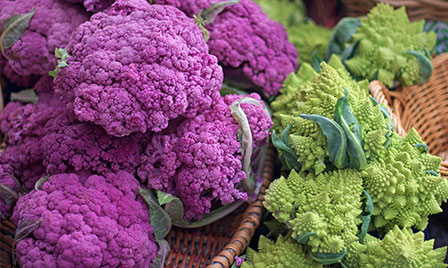
NOURISH
Farmers market finds: Eat the rainbow
Posted September 28, 2017
- Purple sweet potato varieties are a good source of anthocyanin, which contains anti-inflammatory properties.
- Asparagus can be green, white or even purple in color. The green variety is most common.
- Butternut squash is loaded with Vitamin A and beta carotene, both important for good vision and a healthy immune system.
Late summer and autumn at my farmer's market bursts with vibrant colors. Walking around your local farmers market you're bound to see a variety of colorful fruits and vegetables, some familiar and some not. A variety of colors on your plate is not only visually pleasing, but the elements that give fruits and vegetables their bright colors also pack a punch with nutritional and health benefits.
Here are some ideas to get you started eating the rainbow:
- One simple strategy is to include as many different colors of fruits and vegetables on your plate as possible.
- Stretch your family's eating habits by choosing something they already like in a different color. For example, try an heirloom brown or yellow tomato.

- Instead of the usual bunch of orange carrots, try some that come in a range of colors, from white to purple, or green or purple cauliflower.

- Use red/purple cabbage instead of, or in addition to, green cabbage in coleslaw and salads.
- Have a seed-spitting contest after enjoying a yellow watermelon

- Use fresh red or green apples as an ingredient in your salads. They add a nice crunch and sweet tang.

- Think you don't like squash? There are many types of winter squash, some of which are incredibly sweet when roasted. Or try spaghetti squash for a fun, gluten-free swap of traditional pasta.

- If you're not sure what a certain fruit or vegetable is, ask. Many farmers market vendors are happy to explain their produce and give suggestions on how to best prepare items. Roasting or grilling vegetables is a great alternative to eating them raw.
MORE ARTICLES LIKE THIS
EMPOWER YOURSELF
Get fun, inspiring, provider-reviewed articles sent to your inbox.
Sign up for our email newsletter




